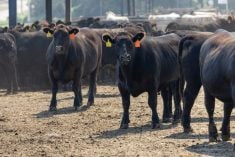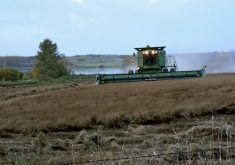By Theopolis Waters
March 28 (Reuters) – The U.S. hog herd fell by three percent in the latest quarter, U.S. government data showed on Friday, far less than some in the industry had anticipated given the spread of a deadly pig virus on U.S. farms.
“The industry is definitely not in step with what the government is saying, said U.S. Commodities analyst Don Roose.
The U.S. Department of Agriculture report showed the U.S. hog herd as of March 1 at 97 percent of the year-ago level, at 62.899 million head. Analysts, on average, expected 61.493 million head, or 94.5 percent of the year-earlier herd. The U.S. hog herd for the same period last year was 65.072 million head.
Read Also

Canadian trade data delayed by U.S. government shutdown
Canadian international trade data for September will be delayed indefinitely due to the ongoing partial shutdown of the United States government, Statistics Canada said Friday, Oct. 24.
The herd number was the smallest for the month of March since 61.896 million in 2007.
The March 1 supply of market-ready hogs was 96 percent of a year earlier at 57.048 million head. Analysts, on average, expected a six percent decline, or 55.683 million. Last winter’s market hog supply was 59.236 million head.
“We knew they would be conservative, but we didn’t think they would be this conservative,” said Allendale Inc chief strategist Rich Nelson.
Jim Robb, director of the Livestock Marketing Information Center said those who held strong convictions about the broader extent of the disease spread will not be swayed by Friday’s results.
Government revisions to the previous reports were noticeable in Friday’s data but not as significant as in prior reports, said Robb.
The Porcine Epidemic Diarrhea virus, known as PEDv, has already crimped available supplies of hogs which sent their price to record highs.
The latest USDA data showed the number of confirmed cases of PEDv on U.S. farms totaled over 5,000. That is nearly triple the number of cases reported when the government issued the December hog survey.
The virus is fatal to baby pigs, but official numbers of actual deaths are unavailable. Still, some economists estimated those losses at roughly 4 to 5 million.
The data showed pigs per litter during the period at 9.53 head, or 95.0 percent of the record high of 10.08 in the year-ago period. Analysts expected an average 9.75 head.
“Clearly the pigs per litter being down is reflective of this disease,” said Robb.
Ron Plain, a University of Missouri livestock economist called the data’s state-by-state pigs per litter breakdown “uneven,” suggesting a possible sampling error on the part of the government.
“USDA’s number may be a bit iffy, but it is an unusual situation they’re trying to deal with,” he said.
HERD EXPANSION UNDERWAY?
The U.S. breeding herd was just over 100 percent of the year-ago level, at 5.851 million head, compared with average trade expectations for 99.6 percent, or 5.813 million. A year ago the breeding herd was 5.836 million head.
While some hog farmers were coping with production issues pegged to PEDv, others largely unaffected by the disease held back breeding animals in their bid to capitalize on huge profits in the coming months, analysts said.
According to analysts, Chicago Mercantile Exchange hog futures could drop as much as the 3-cents per pound price limit on Monday, based on Friday’s report.
Market activity could prove volatile as participants even up positions on the last trading day of the month and the end of the quarter.
“This report will be thrown in the mix with the deferred contracts likely to see more pressure from the report than the nearby trading months,” said Robb.














